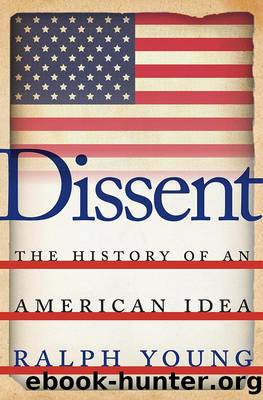Dissent: The History of an American Idea by Ralph F. Young

Author:Ralph F. Young
Language: eng
Format: azw3, mobi, pdf
Tags: HIS036000 History / United States / General
ISBN: 9781479801190
Publisher: New York University Press
Published: 2015-12-15T15:57:40+00:00
Mother Jones, 1915. Photograph of the labor activist Mother Jones (1837â1930) attending the 1915 hearings of the federal Commission on Industrial Relations at New York City Hall. (Public domain; courtesy Library of Congress)
Despite the efforts of Jones, Addams, Kelley, Hine, and so many other activists (both progressives and radicals), it was not until the New Deal in the 1930s that child labor was effectively regulated at the federal level, when another Roosevelt signed the Fair Labor Standards Act prohibiting child labor under the age of fourteen and setting strict limits on the hours and type of work for children between the ages of fourteen and eighteen.
Progressive reformers also targeted the working conditions of New York Cityâs garment industry, which employed thousands of young women (mostly Italian and Jewish immigrants) in hundreds of sweatshops throughout lower Manhattan. These women worked long, fifty-six hour weeks, in unsafe, miserable conditions for one dollar a day making dresses and shirtwaists (blouses). The companies, seeking to maximize profits, forced the women to rent their sewing machines (sometimes even requiring that they pay for the electricity) and made them take their breaks at their stations. In 1909 nearly twenty thousand garment workers walked off their jobs, demanding better working conditions. Supported by the International Ladiesâ Garment Workers Union and dozens of the cityâs clergymen, the women won. But not all the shirtwaist manufacturers improved working conditions, and many of the sweatshops remained unsafe. The Triangle Shirtwaist Company, for example, still required employees to take their breaks at their sewing machines, and to ensure they did the managers routinely kept the doors to the workshop locked so the women could not even go out into the hallway.
On March 25, 1911, a fire broke out in the eighth-floor workshop. Most of the doors were locked; but even those that were unlocked swung inward, and the press of panicked women trying to escape prevented the doors from opening. The elevators did not work. There were no fire escapes. The fire departmentâs ladders only reached to the seventh floor. The women were trapped. With flames and smoke engulfing them many women, in threes and fours, holding hands, leapt to their deaths. âThey jumped with their clothing ablaze,â one newspaper reported. âThe hair of some of the girls streamed up aflame as they leaped. Thud after thud sounded on the pavements.â12 When it was all over, 146 women were dead. None of the managers died.
The public was outraged. The governor established a commission to investigate working conditions throughout the state. The commissionâs findings, after five years, eventually led to the enactment of legislation that set safety standards for the workplace, prohibited the employment of children under fourteen, and limited womenâs working hours to fifty-four per week. From 1911 on it became clear to politicians and the public that the government needed to establish regulations that would improve the safety of the workplace for all workers. In the long run, the Triangle Shirtwaist Company fire had a positive impact. It raised public
Download
Dissent: The History of an American Idea by Ralph F. Young.mobi
Dissent: The History of an American Idea by Ralph F. Young.pdf
This site does not store any files on its server. We only index and link to content provided by other sites. Please contact the content providers to delete copyright contents if any and email us, we'll remove relevant links or contents immediately.
The Secret History by Donna Tartt(16658)
The Social Justice Warrior Handbook by Lisa De Pasquale(11494)
Thirteen Reasons Why by Jay Asher(7801)
This Is How You Lose Her by Junot Diaz(5799)
Weapons of Math Destruction by Cathy O'Neil(5046)
Zero to One by Peter Thiel(4834)
The Myth of the Strong Leader by Archie Brown(4795)
Promise Me, Dad by Joe Biden(4455)
Beartown by Fredrik Backman(4433)
Stone's Rules by Roger Stone(4422)
How Democracies Die by Steven Levitsky & Daniel Ziblatt(4413)
The Fire Next Time by James Baldwin(4350)
100 Deadly Skills by Clint Emerson(4085)
A Higher Loyalty: Truth, Lies, and Leadership by James Comey(4039)
Rise and Kill First by Ronen Bergman(4020)
The David Icke Guide to the Global Conspiracy (and how to end it) by David Icke(3891)
The Farm by Tom Rob Smith(3878)
Secrecy World by Jake Bernstein(3788)
The Doomsday Machine by Daniel Ellsberg(3737)
